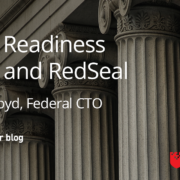Cyber Readiness Pillars and RedSeal
Cybersecurity readiness is an excellent tool that has the ability to provide you with the right services. It has the ability for identifying, preventing and responding to cyber threats. This tool is required by organizations all over the world, and organizations that lack this strategy are prone to more cybersecurity threats.
The Cybersecurity and Infrastructure Security Agency (CISA) suggested and developed the Cyber Essentials for small businesses. Along with these businesses, the local government leaders are also provided with ideas on how to successfully make an actionable understanding of how to implement organizational cybersecurity practices.
CISA leaders offered a detailed awareness of how the pillars of Cyber Essentials are important. Building a corporate culture is required for cybersecurity and the organization which fails to do so faces cyber-attacks. During a webinar with the U.S. Chamber of Commerce on June 29, CISA provided a starting point for better flexibility considering cyber readiness.
“From human resources to marketing to sales and procurement, it is almost guaranteed that you rely on one or more digital platforms to facilitate the success of your business operations. The Cyber Essentials are a series of tools and practices that we have assembled to provide what we consider to be the basics of cyber organizational readiness,” Trent Frazier, deputy assistant director of the Stakeholder Engagement Division at CISA, said.
Every team requires to have a safe cybersecurity practice. If you don’t have a holistic approach towards it, then, you are one organization that is in danger. Great help from the global leader is what you require in this case. RedSeal is a company that you can depend on for sophisticated cybersecurity.
RedSeal as a force multiplier for every other security device within a network is indulged in cybersecurity. If you have short of skilled cybersecurity personnel, then, don’t forget to connect with us.
The 6 Pillars of Cyber Readiness
Creation of Cyber Readiness Culture
Pillar One
Pillar one of cyber readiness is leadership. The leaders are always the backbone of an organization and a great help in maintaining the business culture.
That is why it is suggested that the leaders shouldn’t forget to keep the essential cybersecurity in mind. The leaders should not overlook the essential investment required in cybersecurity. They should also determine how much work is dependent on IT and have a trusted relationship with the sector partners and government agencies. It is required to have a trusted relationship so that the cyber threat information can get easily accessed.
Pillar Two
The second pillar of cyber readiness is the staff. The people associated with the organization’s system are an essential part of this readiness. This element’s task is developing awareness and alert about cybersecurity.
Systems and Data Environment in Cyber Readiness
Pillar Three
The third pillar consists of systems and leaders being taught and trained on what is present in their network. Also, they are offered knowledge on how to maintain hardware and software assets inventories. It will help them in letting them know what is there and what things are at risk because of the attack.
Pillar Four
The fourth pillar advises the leaders to have knowledge on:
- The network
- Maintenance of inventories of network connects including user accounts and vendors
- Multiple-factor authentication for every user, starting with those who have privileged, administrative, and remote access
Pillar Five
The fifth pillar of cyber readiness is the data, intellectual property along with another delicate information present within the organization. In this case, the leaders and staff get tasked with learning how the data can get protected.
Respond to and Recover from a Crisis
Pillar Six
Crisis response is the sixth and last pillar in the Cyber Essentials. It focuses on restricting the damage and rushing restoration of the normal operations after a cyber-attack.
The Cyber Essentials have given the authority and tasked leaders for the development of an incident response along with a disaster recovery plan. This plan should outline the roles and responsibilities and should get tested often for cybersecurity needs.
Leaders should know and be aware of the cybersecurity of the organization. Their assessment will influence the business impact as well. Also, the leaders should have proper security on which systems should be recovered at the earliest.
As a leader, the person should be well aware of who to call for help if they don’t have sufficient staff for it. Learn who should be the people that you should call for help first. These can include outside partners, government, technical advisors, and law enforcement.
If by any chance you are looking for cybersecurity services, then, our platform is the one. We offer the following cybersecurity services.
RedSeal Service Offerings
- Cloud Cyber Inventory Assessment
- Cyber Visibility Assessment
- Health Check Service
- Secure Remote Work Assessment
- Managed Service
- Cyber Cloud Access Assessment
Our professional services are the solution to all your cybersecurity answers. We work as a team and offer skilled and trained cybersecurity personnel. Along with them, we offer cybersecurity products that make your investment more valued.
The Bottom Line
Organizations need a cybersecurity strategy to protect both infrastructure and customer data from growing cybersecurity threats. The Cybersecurity and Infrastructure Security Agency (CISA) developed the Cyber Essentials as a guide for small businesses and local government leaders to develop an actionable understanding of where to start implementing organizational cybersecurity practices.

